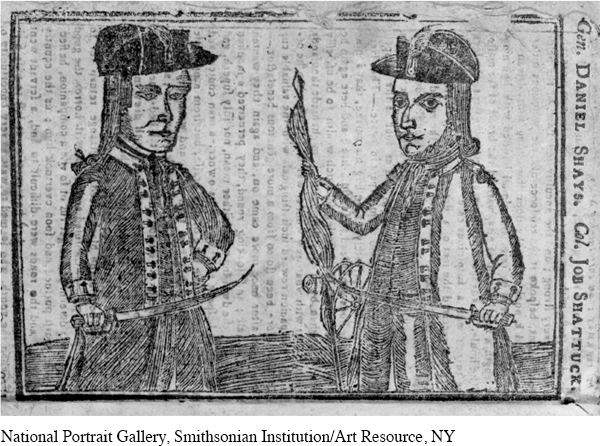Indebted Farmers Fuel Political Crises
Unlike blacks, Indians, and women, many farmers and workingmen hoped to expand their political role in the new nation. Under constitutions written during the Revolution, most state governments broadened the electorate, allowing men with less property (or in some cases no property) to vote and hold office. They also increased representation from western areas.
Still, the economic interests of small farmers and workers diverged sharply from those of wealthy merchants and large landowners. As conflicts between debtors and creditors escalated between 1783 and 1787, state governments came down firmly on the side of the wealthy. But indebted farmers did not give up. They voted, petitioned, and protested to gain more favorable policies. When that failed, debt-ridden farmers in New Hampshire marched on the state capital in September 1786, demanding reform. But they were confronted by cavalry units, who quickly seized and imprisoned their leaders.
Assaults on national authority worried many political leaders far more than farmers’ uprisings. The continued efforts of Great Britain and Spain to undercut U.S. sovereignty and ongoing struggles with Indian nations posed especially serious threats. When James Madison and Alexander Hamilton attended the 1785 convention in Annapolis to address problems related to interstate commerce, they discovered that their concerns about the weakness of the confederation were shared by many large landowners, planters, and merchants. Despite these concerns, state legislatures were reluctant to give up the powers conferred on them under the Articles of Confederation.
Still, it was Shays’s Rebellion, the armed uprising of indebted farmers in western Massachusetts in 1786 to 1787, that crystallized fears among prominent patriots about the limits of the confederation model. On December 26, 1786, Washington wrote Henry Knox to express his concerns about the rebellion and upheavals along the frontier: “If the powers [of the central government] are inadequate, amend or alter them; but do not let us sink into the lowest states of humiliation and contempt.” Hamilton agreed, claiming that Shays’s Rebellion “marked almost the last stage of national humiliation.”

REVIEW & RELATE
How did America’s experience of the Revolutionary War change the lives of African Americans and women?
What do uprisings by farmers and debtors tell us about social and economic divisions in the early Republic?
Exploring American HistoriesPrinted Page 216
Exploring American Histories Value EditionPrinted Page 161
Chapter Timeline